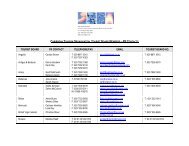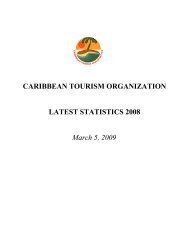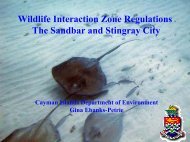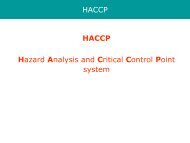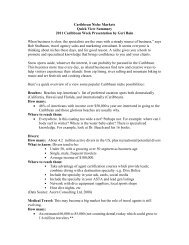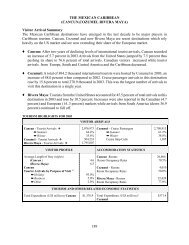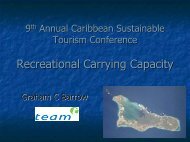Disaster Risk Management Strategy and Plan of Action - Caribbean ...
Disaster Risk Management Strategy and Plan of Action - Caribbean ...
Disaster Risk Management Strategy and Plan of Action - Caribbean ...
Create successful ePaper yourself
Turn your PDF publications into a flip-book with our unique Google optimized e-Paper software.
Regional <strong>Disaster</strong> <strong>Risk</strong> <strong>Management</strong> <strong>Strategy</strong> for the Tourism Sector in the <strong>Caribbean</strong> – Final<br />
emanating from natural hazards <strong>and</strong> in managing disasters, in order to support the attainment <strong>of</strong> their social <strong>and</strong> economic<br />
development goals…” 24 This policy is broad in that it clearly addresses pre- <strong>and</strong> post-event aspects. Clear<br />
reference is made to mitigation, preparedness <strong>and</strong> recovery. No direct mention is made <strong>of</strong> response but it<br />
is implied in the purpose by the use <strong>of</strong> the term “managing disasters”. This policy specifically defines areas<br />
<strong>of</strong> coverage <strong>and</strong> exclusion. For example, hazards excluded from the policy are:<br />
o Prevention <strong>and</strong> mitigation <strong>of</strong> disasters caused by social <strong>and</strong> political violence;<br />
o The prevention <strong>of</strong> technological hazards;<br />
o Epidemics <strong>and</strong> p<strong>and</strong>emics - covered by the Bank’s Public Health Policy;<br />
o <strong>Risk</strong> management related to the Bank’s personnel <strong>and</strong> installations (which is covered in the Bank’s<br />
Business Continuity <strong>Plan</strong>); <strong>and</strong>,<br />
o Financial emergencies which are treated through the Bank’s Emergency Lending Guidelines.<br />
In short, the Regional DRM <strong>Strategy</strong> for the Tourism Sector in the <strong>Caribbean</strong>, informed by the IDB DRM<br />
Policy <strong>and</strong> adhering to the ISDR’s Living with <strong>Risk</strong>, aims to guide CTO membership in furthering the<br />
objectives <strong>of</strong> the <strong>Caribbean</strong> Sustainable Tourism Policy Framework (Goal 6) <strong>and</strong> also contributes to the<br />
Enhanced CDM <strong>Strategy</strong> <strong>and</strong> Framework.<br />
2.3 Scope <strong>of</strong> the DRM <strong>Strategy</strong> for the Tourism Sector in the <strong>Caribbean</strong><br />
2.3.1 Hazards in the <strong>Caribbean</strong><br />
Not all countries in the region are susceptible to be affected to<br />
the same degree by the variety <strong>of</strong> common natural hazard.<br />
Although different studies form varied conclusions based on<br />
utilization <strong>of</strong> different methodologies, criteria <strong>and</strong><br />
benchmarks, the importance <strong>of</strong> these relative vulnerability<br />
studies is that they agree that different countries in the<br />
<strong>Caribbean</strong> have different levels <strong>of</strong> exposure <strong>and</strong> vulnerability<br />
to the common hazards (including hurricanes, earthquakes,<br />
floods, volcanoes <strong>and</strong> droughts).<br />
Figure 1 on the right shows the relative importance <strong>of</strong> the<br />
natural hazard phenomena <strong>of</strong> a total <strong>of</strong> 399 events registered<br />
for the period 1950-2008. 25<br />
2.3.2 Hazards in focus for the <strong>Strategy</strong><br />
Although the focus <strong>of</strong> the strategy is natural hazards, particularly those categorized as low frequency/high<br />
consequences, it does not follow that all other hazards are excluded from consideration. In terms <strong>of</strong><br />
hazard, the Regional <strong>Strategy</strong> <strong>and</strong> <strong>Plan</strong> <strong>of</strong> <strong>Action</strong> are scoped to those caused by natural phenomena <strong>and</strong> to<br />
their potential consequences within the <strong>Caribbean</strong> region.<br />
24 Inter-American Development Bank, Draft DRM Policy, December 21, 2005. p. 2<br />
25 Adapted from EM-DAT: Emergency Events Database. Centre for Research on the Epidemiology <strong>of</strong> <strong>Disaster</strong>s (CRED).<br />
Université Catholique de Louvain. Internet resource: www.emdat.be<br />
15








